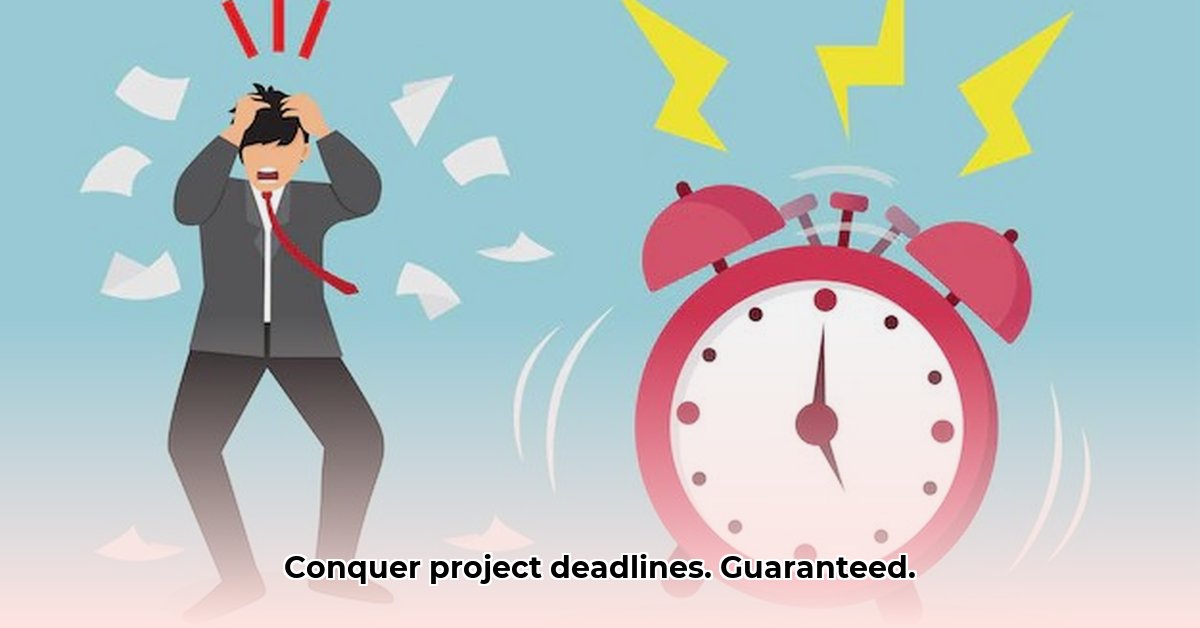In today’s dynamic environment, delivering projects on time and within budget is the hallmark of successful project managers. This guide offers crucial insights, a simplified framework, and proven strategies to consistently achieve outstanding results. Learn how to master project estimations, schedule management, and stakeholder collaboration to become a project time management expert. For more on managing time effectively, check out this helpful article on slack time.
Achieving On-Time Delivery: A Strategic Approach
Delivering projects on schedule is a skill that can be honed with the right approach. This guide provides actionable strategies to enhance your project time management capabilities and consistently achieve project goals.
Accurate Estimations: The Bedrock of Project Success
Precise estimations are fundamental to project success. Inaccurate estimations lead to unrealistic deadlines and ultimately, project delays. Improve your estimation accuracy by adopting these key practices:
- Decompose Tasks: Break down large, complex tasks into smaller, more manageable sub-tasks. This allows for more accurate time and resource allocation. For instance, instead of “Develop Website,” break it down into “Design Mockups,” “Front-End Development,” “Back-End Development,” and “Testing.”
- Leverage Historical Data: Analyze data from past projects to identify trends and patterns. This historical perspective provides valuable insights into the time required for similar tasks.
- Involve Your Team: Include team members in the estimation process. Their expertise and insights can provide realistic assessments of task durations.
- Consider Dependencies: Account for task dependencies, where the completion of one task is required before another can begin.
Work Breakdown Structures (WBS): Organizing for Efficiency
A Work Breakdown Structure (WBS) is a hierarchical decomposition of a project into manageable components. It provides a visual representation of the project’s scope and deliverables, enabling better planning, execution, and control.
- Comprehensive Planning: A WBS ensures that all project tasks are identified and accounted for, reducing the risk of overlooking critical elements.
- Improved Resource Allocation: By breaking down the project into smaller tasks, resource allocation becomes more efficient and targeted.
- Enhanced Communication: A WBS provides a common understanding of the project’s scope and objectives, facilitating communication among team members and stakeholders.
Tools & Technology: Leveraging Digital Assistants
Project management software simplifies complex projects, offering features such as real-time tracking, enhanced collaboration, and automated reporting.
- Centralized Platform: Project management tools provide a centralized platform for managing tasks, timelines, and resources, ensuring that everyone is on the same page.
- Real-Time Tracking: Monitor project progress in real-time with dashboards and reports, allowing for proactive issue identification and resolution.
- Collaboration Features: Facilitate team collaboration with features such as task assignments, discussion threads, and file sharing.
- Automated Reporting: Generate automated reports on project status, resource utilization, and performance metrics, saving time and improving decision-making.
Agile Methodologies: Embracing Flexibility
Agile methodologies emphasize iterative development, collaboration, and flexibility, making them well-suited for projects with evolving requirements.
- Iterative Development: Agile projects are developed in short iterations, allowing for continuous feedback and adaptation.
- Flexibility: Agile embraces change, allowing for adjustments to the project scope and schedule as needed.
- Stakeholder Collaboration: Agile methodologies promote close collaboration between the project team and stakeholders, ensuring that the project meets their needs.
Proactive Monitoring & Control: Staying Ahead of Potential Issues
Consistent monitoring and control are essential for keeping projects on track.
- Regular Check-ins: Conduct regular check-ins to assess project progress and identify any potential issues.
- Performance Metrics: Track key performance indicators (KPIs) to measure project performance and identify areas for improvement.
- Corrective Actions: Implement corrective actions promptly to address any deviations from the project plan.
Contingency Planning: Preparing for the Unexpected
Unexpected delays are inevitable in project management, so contingency planning is crucial.
- Risk Assessment: Identify potential risks and assess their potential impact on the project timeline.
- Mitigation Strategies: Develop mitigation strategies to reduce the likelihood and impact of identified risks.
- Contingency Reserves: Allocate contingency reserves to cover unexpected costs or delays.
Stakeholder Alignment & Communication: Ensuring Everyone is on Board
Clear and consistent communication is essential for maintaining stakeholder alignment and support.
- Regular Updates: Provide regular updates to stakeholders on project progress, risks, and issues.
- Open Communication Channels: Establish open communication channels to facilitate feedback and address concerns.
- Stakeholder Involvement: Involve stakeholders in key decision-making processes to ensure that their needs and expectations are met.
Continuous Improvement: Learning from Every Project
Each project provides opportunities for learning and improvement.
* Post-Project Reviews: Conduct post-project reviews to identify what went well and what could be improved in future projects.
* Lessons Learned: Document lessons learned and share them with the project team and organization.
* Process Enhancements: Implement process enhancements based on lessons learned to improve project management practices.
Practical Strategies: A Summary
| Stakeholder | Short-Term Actions | Long-Term Goals |
|---|---|---|
| Project Manager | Use project management software, create a detailed WBS, track task progress daily. | Master agile and other methodologies, explore AI-powered tools, develop standardized processes, mentor team members. |
| Project Team | Track time accurately, report issues promptly, participate in daily stand-ups. | Improve estimation accuracy, enhance teamwork and communication, actively participate in process enhancements, cross-train on different tasks. |
| Clients/Stakeholders | Participate in progress updates, give timely feedback, attend milestone reviews. | Establish clear, formal agreements outlining expectations and how changes will be handled, engage in collaborative problem-solving, provide constructive feedback. |
| Organization | Invest in training and software upgrades, standardize project processes, promote a culture of transparency. | Emphasize proactive risk management, encourage continuous learning, implement regular project assessments, create a knowledge base of past projects. |
Mastering project time management requires continuous learning, adapting to new challenges, and refining techniques. Consistent success stems from consistent effort and reflection.
Selecting the Right Project Management Software: A Guide for Domain-Specific KPIs
Choosing the right project management software (PMS) is pivotal for ensuring projects are delivered on time and aligned with strategic objectives. The ideal PMS should not only streamline workflows but also provide robust capabilities for tracking and managing domain-specific Key Performance Indicators (KPIs).
Understanding Your KPIs: Tailoring Software to Your Needs
Before diving into software options, clearly define your KPIs. What metrics are most critical to your organization’s success? These KPIs will guide your selection process and ensure that the chosen PMS aligns with your strategic goals.
- Project Completion Rate: The percentage of projects completed successfully within the defined timeframe and budget.
- Budget Adherence: The ability to maintain project costs within the allocated budget.
- Client Satisfaction: The level of satisfaction among clients regarding project deliverables and communication.
- Resource Utilization: The efficiency with which resources (e.g., personnel, equipment) are allocated and used throughout the project lifecycle.
Defining Your Needs: A Comprehensive Checklist
To select the most effective software, consider the following questions:
- Project Types: What types of projects do you manage? (e.g., software development, construction, marketing campaigns)
- Team Size: What is your team size and structure? (e.g., small, medium, large; co-located, distributed)
- Workflow Challenges: What are your current workflow challenges? (e.g., poor communication, inefficient task assignment, lack of visibility)
- Budget: What is your budget for project management software?
- Integration Needs: What level of integration with existing tools (e.g., CRM, accounting software) is required?
- Data Security: What data security and privacy measures are essential?
Evaluating Software Options: A Structured Approach
- Research: Conduct thorough research to identify potential software options that meet your needs. Explore market leaders, emerging platforms, and industry-specific solutions.
- Trial Periods: Take advantage of free trial periods to test software with real-world data. Don’t just explore the dashboard; actively use the software to manage your projects.
- Stakeholder Feedback: Gather feedback from team members, clients, and executives to ensure that the software meets the needs of all stakeholders.
- KPI Integration: Verify that the PMS can track and report on your defined KPIs. Look for features such as customizable reports, real-time dashboards, and automated alerts.
- Scalability: Determine whether the PMS can scale with your organization’s growth and evolving needs.
- Security: Analyze the software’s security features, including data encryption, access controls, and disaster recovery mechanisms.
- Vendor Support: Evaluate the vendor’s support services, including documentation, training, and technical assistance.
- Implementation: Develop a detailed implementation plan, including data migration, user training, and ongoing support.
Prioritizing Features Based on Your KPIs
| KPI | PMS Features | Example Software (Illustrative Only) |
|---|---|---|
| On-Time Project Delivery | Gantt charts, timelines, progress tracking, critical path analysis | Asana, Monday.com |
| Budget Adherence | Cost tracking, budgeting tools, expense reports, variance analysis | Jira, Trello |
| Resource Utilization | Resource allocation, workload management, task assignments, capacity planning | Wrike, ClickUp |
| Client Satisfaction | Communication tools, feedback mechanisms, progress reporting, client portals | Basecamp, Nozbe |
Making the Decision: Key Considerations
Carefully weigh the pros and cons of your top choices. The PMS should streamline workflows, enhance collaboration, and support project delivery.
- User Interface: Choose a PMS with an intuitive and user-friendly interface that is easy for team members to adopt.
- Customization: Select a PMS that allows for customization to align with your organization’s specific workflows and requirements.
- Integration: Ensure that the PMS integrates seamlessly with your existing tools and systems to avoid data silos and streamline processes.
- Cost: Consider the total cost of ownership, including software licenses, implementation fees, and ongoing maintenance and support costs.
Project Time Management Strategies for Agile Environments
Effective time management is crucial for achieving on-time project delivery in agile environments. Agile methodologies demand flexible scheduling and adaptable time management techniques.
Mastering Agile Time Estimation
Accurate time estimations are the cornerstone of agile projects.
- Team Collaboration: Engage the entire team in collaboration.
- Relative Estimation: Use techniques like planning poker or story points.
- Refinement: Regularly review estimations, adjusting them as you learn more.
Agile Scheduling: Embracing Flexibility
Agile requires iterative development and adaptive planning.
- Sprint Planning: Define user stories within a sprint.
- Daily Stand-ups: Maintain momentum and address impediments with brief meetings.
- Sprint Reviews: Evaluate progress and make adjustments to sprints.
- Sprint Retrospectives: Analyze successes and failures to improve processes.
Progress Tracking and Monitoring
Transparent progress tracking is essential.
- Utilize Agile Project Management Tools: Tools like Jira, Asana, or Trello provide real-time visibility.
- Visualize Progress: Kanban boards or charts provide a clear picture of the team’s progress.
- Regular Reporting: Maintain communication with stakeholders, providing updates.
Risk Management in Agile Projects
Issues are inevitable so proactive risk management is key.
- Identify Potential Risks: Regularly assess potential challenges.
- Develop Mitigation Strategies: Create plans to address identified risks.
- Monitor and Adapt: Continuously monitor risks and adjust strategies as needed.
Effective Project Time Management Strategies: A Summary
Effective Project Time Management Strategies necessitate a shift from planning to adaptive strategies. Through estimation, scheduling, tracking, and risk management, agile teams can deliver projects on time. Remember, agility is about embracing change; time management is about mastering it.
Effective Time Management in Complex Project Landscapes
Navigating the complexities of modern projects requires a strategic approach to time management. This section provides a framework for mastering time management in challenging project environments.
Mastering Project Estimation: The Foundation of Success
Inaccurate estimations are a common cause of project delays.
- Leverage Historical Data: Analyze data from past projects.
- Incorporate Team Experience: Involve team members in the estimation process.
- Use Three-Point Estimation: Account for optimistic, pessimistic, and most likely scenarios.
Building Robust Project Schedules: A Blueprint for Success
A structured schedule is your roadmap for project success.
- Use Project Management Software: Visualize dependencies between tasks.
- Prioritize Strategically: Focus on critical tasks and milestones.
- Build Buffer Time: Incorporate buffer time into your schedule to account for unexpected delays.
Consistent Tracking and Control: Steering Your Project to the Finish Line
Consistent monitoring is essential for keeping projects on track.
- Real-Time Tracking: Utilize project management software for real-time tracking.
- Regular Reporting: Keep stakeholders informed of progress and potential challenges.
- Proactive Issue Resolution: Address issues promptly to minimize their impact on the project timeline.
Communication: The Glue That Holds Everything Together
Effective communication is often overlooked, but it is crucial for project success.
- Establish Clear Communication Channels: Define how information will be shared among team members and stakeholders.
- Centralize Information: Use project management tools to centralize information and documentation.
- Conduct Regular Status Meetings: Address concerns and adjust the project plan as needed.
Navigating the Unexpected: Adaptability in Action
Unexpected events are inevitable in project management.
- Embrace Change: Utilize agile methodologies to adapt to changing requirements.
- Regularly Review Scope and Schedule: Adjust the project scope and schedule as needed.
- Maintain Flexibility: Be prepared to adapt your plans in response to unforeseen events.
Stakeholder Collaboration: A Shared Responsibility
Successful project delivery depends on collaboration.
- Involve Stakeholders in Planning: Seek input from stakeholders during the planning phase.
- Conduct Progress Reviews: Provide regular updates to stakeholders and solicit their feedback.
- Promote Trust and Transparency: Establish a collaborative environment based on trust and transparency.
- Unlock Work-Life Harmony:Your Guide to Integration - November 27, 2025
- Find Your Work-Life Balance Quotes: Achieve Harmony Now - November 25, 2025
- Unlock Physician Assistant Work Life Balance: Your Guide to Fulfillment - November 23, 2025
















